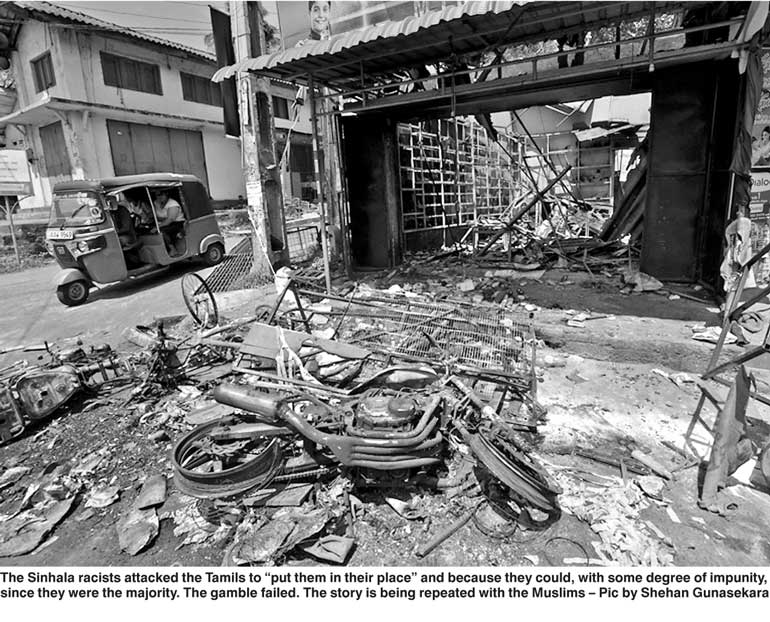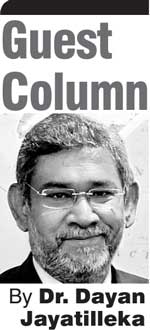Saturday Jan 11, 2025
Saturday Jan 11, 2025
Saturday, 10 March 2018 00:49 - - {{hitsCtrl.values.hits}}

The recent spate of attacks on Muslims is the latest manifestation of Islamophobia in Sri Lanka. Such violence cannot but have the effect of radicalising Muslim youth and marginalising Muslim moderates. We have come one step closer to the emergence of Islamist terrorism in Sri Lanka.
So far we have experienced a ghastly increase in Islamic religious fundamentalism within the Muslim community, especially but not exclusively in the east. However, there is a vital difference between Islamic fundamentalism and Islamist terrorism.
Not all Muslims are religious fundamentalists. There is also a difference between Islamic radicalism (e.g. Hezbollah, Hamas) and Islamic fundamentalism (e.g. Wahhabis). The latter is far more regressive and dangerous than the former, which has an emancipatory content. Religious fundamentalism and religious radicalism are not armed and violent, except verbally so in some cases. Terrorism is.
Terrorists are Islamist, not Islamic. Islamism is their ideology, not the religion they practice. All Islamist terrorists are Islamic fundamentalists but not all Islamic fundamentalists are Islamist terrorists. Religious fundamentalism harms only the Muslim community itself, but not other communities nor the State.
If and when Islamic religious fundamentalism spawns Islamist armed extremism it will hurt other communities and the state. Nothing is more likely to generate Islamist terrorism on this island than the news, the sight and the emotions of Sinhala mobs, sometimes with Buddhist monks in their ranks, attacking Muslims.
The Sinhala racists made the same mistake with the Tamils. Mob violence was visited upon the Tamils in 1956, 1958, 1977, 1979, 1981 and 1983. The Tamil Tigers were formed in 1976, with Prabhakaran taking over as Chairman in 1978. The vast expansion of Tamil terrorism, as distinct from the commencement of Tamil armed insurgency—not all insurgencies are terrorist—followed Black July 1983.
The Sinhala racists attacked the Tamils to “put them in their place” and because they could, with some degree of impunity, since they were the majority. The gamble failed. It is true that the Tamils, by resorting terrorism, lost the civil war and the south won, but the Tamil issue has been internationalised to a point that is irreversible. So the visiting of mob violence upon the Tamils in 1958, 1977 and 1983 did not have the desired result and indeed achieved its opposite.
The story is being repeated with the Muslims. Contrary to liberal myth, contemporary Islamophobia did not commence with the BBS in 2012. Contemporary Islamophobia was the twin of contemporary Christianophobia. It started with the phenomenon of Rev Soma Thero, his sermons on TV, the correct discontinuation of them by the ITN, the switch of Rev Soma to the TNL, and the Rev Soma versus M.H.M. Ashraff debate on television. Among Ashraff’s transgressions in the eyes of Rev. Soma was that he had penned a (very respectful and celebratory) poem on Lord Buddha.
The ideological and political weaponisation of Ven. Soma’s message and legacy by Champika Ranawaka after the Thero’s sudden demise through medical misadventure, was the quantum leap in Islamophobia. It was in the second term of the Chandrika Bandaranaike Kumaratunga administration, and against that administration, that Sinhala Buddhist fundamentalism raised its head. There was a spate of attacks on Christian churches, mainly but not only evangelical. X’mas 2003 had to be celebrated with armed police standing outside—and some sitting inside—churches, including mainline Catholic ones, such as the church which I visited.
Sinhala Buddhist fundamentalism developed a militant offshoot, called the National Movement against Terrorism, which expressed itself on issues other than that of terrorism. While that militant offshoot was not itself violent, there were other shadowy outfits with names like the Theraputthabhaya Balakaaya and the Mahasona Balakaaya (not to be confused with the anti-Tiger covert operationsunit within the armed forces, which came later) and which used to send out death threats.
The Shah Rukh Khan concert was denounced because it was scheduled on the same day as the first death anniversary of the demise of Rev Soma. A hand grenade was thrown and an innocent died, while the daughter of the highly efficient and respected OIC of the Kirulapone Police Station was seriously wounded. The killer was never caught. That was in 2004.
Champika Ranawaka pushed for the so-called Anti-Conversion Bill in 2005, well before the Presidential election. At a discussion in the US Senate building in Autumn 2005 (on which occasion I was lucky enough to run into and speak with Sen. Edward Kennedy), I was informed by a top staffer to an important Senator, that there had been an overcrowded meeting of Senators from both the Republicans and the Democrats, the biggest ever on Sri Lanka, to call for action against Sri Lanka on the issue of the Anti-Conversion Bill. As usual, the Sinhala Buddhist chauvinists who had picked on the small Evangelical community in Sri Lanka because it as tiny and could be bullied, failed to understand its huge clout in the world’s strongest superpower!
It is none other than Mahinda Rajapaksa, shortly upon election as President, who vetoed the Anti-Conversion Bill, and put a stop, temporarily, to the anti-Christian surge and saved Sri Lanka from full-on American hostility when we were fighting the war.
It was in the immediate aftermath of the war that a fresh wave of Islamophobia commenced. That was over Digavapi and was driven by Champika Ranawaka. His new line in Government was that ‘the Sinhalese and Tamils fought each other but it was the Muslims who have gained ground and are the new threat.’
This new thrust of Islamophobia was further radicalised in 2012, not only with the emergence of the BBS but also with a more virulent manifestation calling itself “Dolahe Karalla” (the Revolt of 2012) , which had logos of swords and other deadly weapons. Soon, the social media was filled with hate speech directed against Muslims, especially women, even in offices. Threats of rape and killing were made, sometimes with the photographs of those making the threats.
When Dinesh Gunawardena and Wimal Weerawansa urged in Cabinet that the inaugural meeting of the BBS in Maharagama be banned, and President Rajapaksa was nodding in agreement, it was Champika Ranawaka who argued vehemently against it, warned that there would be a violent backlash, and threatened to walk out and join the rally. He prevailed. The BBS held its rally with bodyguards dressed in black, looking every bit like a para-military. Champika Ranawaka was a distinguished guest.
 The same reversal happened after Aluthgama, when President Rajapaksa, on a flight from Japan, ordered the arrest of Rev Gnanasara. Champika lobbied the defence circles he had become acquainted with during the war years, and struck the same note that there would be a Sinhala Buddhist backlash were the BBS boss arrested. The idea was dropped.
The same reversal happened after Aluthgama, when President Rajapaksa, on a flight from Japan, ordered the arrest of Rev Gnanasara. Champika lobbied the defence circles he had become acquainted with during the war years, and struck the same note that there would be a Sinhala Buddhist backlash were the BBS boss arrested. The idea was dropped.
During the presidential election campaign of December 2014, a tape surfaced, with video and audio, which was aired on television and has never been denied by the person in it, namely Minister Rajitha Senaratne.
He was in conversation, allegedly along with his son, in which he marvels at the Satanic duplicity of Champika Ranawaka: “First he blocked any post war reconciliation with the Tamils by opposing the implementation of the 13th Amendment while in Cabinet, then he picked on the Muslims and drove them away, and having thus split the minorities from Mahinda, he then revolted against Mahinda and split some Sinhala Buddhist votes away. What a plan! Evidently this plan had been in operation since 2010 or 2011! What a guy! I didn’t know this stuff till recently!” he said, in Sinhala.
The next phenomenon was that of the “Sinha-LEY” (Sinhala Blood), a few years back. Then came the attack on the UN safe house of the Rohingya refugees last year.
Now comes the Ampara and Kandy attacks. The timing is amazing, as is the answer to the crucial question “Cui Bono?”, “Who benefits?” Mahinda Rajapaksa has just beaten both UNP and SLFP and pretty much swept the board at the local elections. He has won back some Muslim votes and his supporters have even won Beruwala which has a Muslim majority. He certainly does not benefit from attacks on Muslims.
Meanwhile the Government has been defeated and is clinging to the hope that a solid bloc of minority votes can be counted up at future elections, most importantly, late next year. Ranil Wickremesinghe is on the ropes with an imminent ‘No Confidence’ motion. And “Hey presto!’ the violent Islamophobic attacks act as a giant eraser, switching the discourse, and making the political threat go away at least for the moment.
I would not be surprised if there are attacks on Catholics too, given that the Sinhala Catholics swung back to Mahinda at the recent election.
More attacks on Muslims could eventually trigger Islamist terrorism by youths armed, trained and tested in combat on foreign battlefields, returning home, and perfectly capable of blowing themselves up in the hope of a fast-track to Heaven. This will certainly not benefit the Muslim community. Nor will it benefit the Sinhala majority because the almost inevitable Black July 83 type reaction would (a) drive the Muslims into the arms of the latently separatist Tamils, while (b) making us lose our old friends such as Pakistan and (c) generating an economic response (migrant labour markets) from within the billion strong global Islamic community.
Provoking the emergence of Islamist terrorism would however, help a Government that is in crisis to impose harshly authoritarian measures and push through a new Constitution by a referendum, sell off national assets to the Indians in the hope of securing their military umbrella for entrenchment in office, and even have a stab at postponing elections. Above all it will make way for a militarist strongman and his Sinhala Mephistopheles, the Godfather of Islamophobia, to seize power from within the Government, at first using the President as a human shield and then marginalising him.